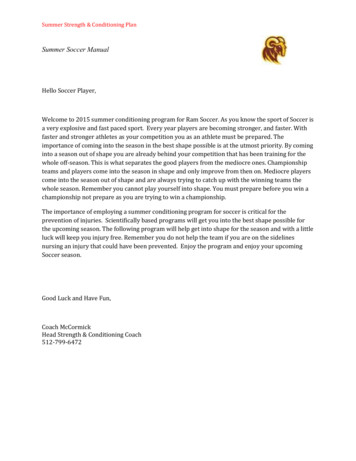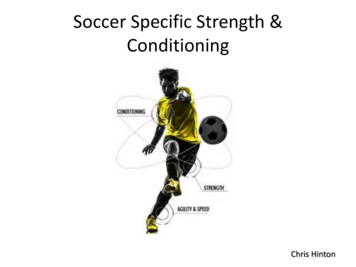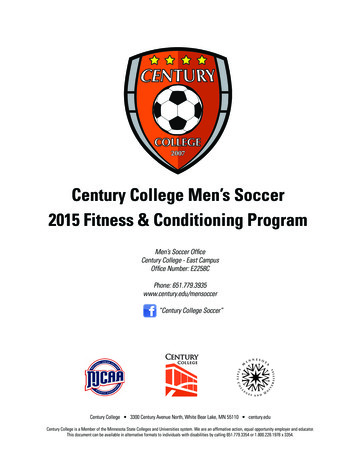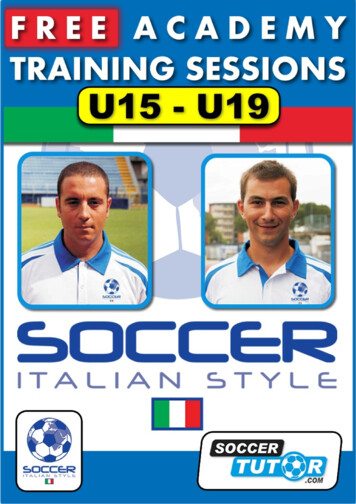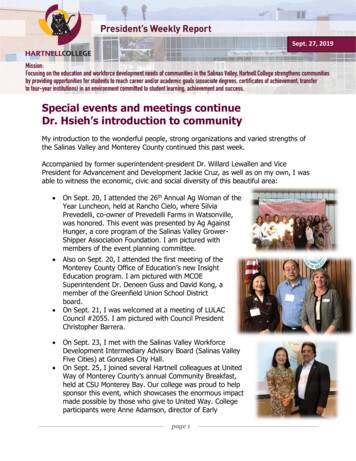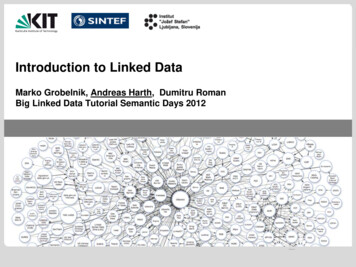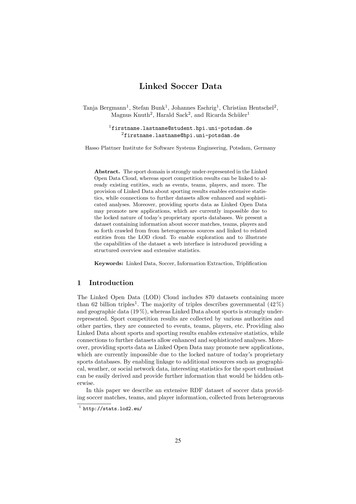
Transcription
Linked Soccer DataTanja Bergmann1 , Stefan Bunk1 , Johannes Eschrig1 , Christian Hentschel2 ,Magnus Knuth2 , Harald Sack2 , and Ricarda dam.de2firstname.lastname@hpi.uni-potsdam.deHasso Plattner Institute for Software Systems Engineering, Potsdam, GermanyAbstract. The sport domain is strongly under-represented in the LinkedOpen Data Cloud, whereas sport competition results can be linked to already existing entities, such as events, teams, players, and more. Theprovision of Linked Data about sporting results enables extensive statistics, while connections to further datasets allow enhanced and sophisticated analyses. Moreover, providing sports data as Linked Open Datamay promote new applications, which are currently impossible due tothe locked nature of today’s proprietary sports databases. We present adataset containing information about soccer matches, teams, players andso forth crawled from from heterogeneous sources and linked to relatedentities from the LOD cloud. To enable exploration and to illustratethe capabilities of the dataset a web interface is introduced providing astructured overview and extensive statistics.Keywords: Linked Data, Soccer, Information Extraction, Triplification1IntroductionThe Linked Open Data (LOD) Cloud includes 870 datasets containing morethan 62 billion triples1 . The majority of triples describes governmental (42 %)and geographic data (19 %), whereas Linked Data about sports is strongly underrepresented. Sport competition results are collected by various authorities andother parties, they are connected to events, teams, players, etc. Providing alsoLinked Data about sports and sporting results enables extensive statistics, whileconnections to further datasets allow enhanced and sophisticated analyses. Moreover, providing sports data as Linked Open Data may promote new applications,which are currently impossible due to the locked nature of today’s proprietarysports databases. By enabling linkage to additional resources such as geographical, weather, or social network data, interesting statistics for the sport enthusiastcan be easily derived and provide further information that would be hidden otherwise.In this paper we describe an extensive RDF dataset of soccer data providing soccer matches, teams, and player information, collected from heterogeneous1http://stats.lod2.eu/25
Linked Soccer Datasources and linked to LOD datasets like the DBpedia. The raw data was collectedvia APIs and crawling from authorities’ websites, like UEFA.com or Fussballdaten.de, and is linked to further web resources for supportive information, suchas Twitter postings for most recent information, Youtube videos for multimedia support, and weather information. Based on this aggregated new dataset wehave implemented an interactive interface to explore this data.2Related WorkThe BBC Future Media and Technology department applies semantic technologies according to their Dynamic Semantic Publishing (DSP) strategy [2] to automate the publication, aggregation, and re-purposing of inter-related contentobjects. The first launch using DSP was the BBC Sport FIFA World Cup 2010website2 featuring more than 700 team, group and player pages. But, the dataused by the system internally is not published as Linked Data.An extensive dataset of soccer data is aggregated by footytube. According totheir website3 the data is crawled from various sources and connected by semantic technologies, though the recipes are not described in detail. Footytube’s datainclude soccer statistics about soccer matches and teams, as well as related media content, such as videos, news, podcasts, and blogs. The data is accessible viathe openfooty API but is subject to restrictions that interdict the re-publishingas Linked Data.Generally, it is hard to find open data about sport results, since exploitation rights are possessed by responsible administrative body organizations. Anapproach to liberate sport results are community-based efforts, such as OpenLigaDB4 , which collect sport data for public use. Van Oorschot aims to extractin-game events from Twitter [3]. As to the authors’ best knowledge, the presented dataset provides the first extensive soccer dataset published as LinkedData, consisting of more than 9 million triples.3Linked Soccer DatasetOur intention was to create a dataset including reliable information about soccerevents covering as many historical data as available including recent competitionresults. For this purpose DBpedia as cross domain dataset is not sufficient, sincesoccer data in DBpedia is incomplete and unreliable.The dataset is aggregated from raw data originating from Fussballdaten.de5 ,Uefa.com6 , DBpedia7 , the Twitter feed of the Kicker magazine8 , the Sky ll/world cup //www.fussballdaten.de/http://www.uefa.com/the original http://dbpedia.org/ and German DBpedia http://de.dbpedia.org/have been applied for matchinghttp://twitter.com/kicker bl li26
Linked Soccer DataHD Youtube Channel9 , and weather information from Deutscher Wetterdienst10 .Fussballdaten.de, Uefa.com, and Kicker.de offer match results and player information. The Twitter feed is used both for parsing live match data (Kickerupdates its feed with live results) and to analyse free text tweets for latestnews about players or teams. The time frame of our data collection ranges fromthe 1960s until today and is updated constantly. Updates are scheduled everymatchday, while the Twitter feeds are refreshed every 30 seconds during running games. Additional leagues can be included by setting up new crawlers, orby providing an interface for manual submission. Currently, the dataset containsinformation about 1. and 2. Bundesliga, the Champions League, European andWorld Championships.The data from these sources is converted and persistently stored as RDFtriples describing resources such as soccer player, soccer teams, matches, associations, different types of in-game-events, and seasons. Each entity is referencedby a unique URI, which unites all facts, from whatever source they originate,about the entity.For describing the information about soccer data we have created a vocabulary Soccer Voc 11 , which extends the BBC Sport Ontology[1] with soccer specificclasses and properties.The dataset comprises descriptions of about 57,000 soccer players, 1,500teams, 1,400 clubs, 1,500 referees, 1,800 managers, 700 stadiums, 38,000 matches,97,000 goals, and 207 seasons or competition series. In total 9 million triples havebeen generated up to now. About 3.35 million triples originate from raw datafrom Fussballdaten.de and 2.10 million triples from the UEFA.com website.In order to evaluate the quality of the matching, a percentage of matchedentities has been reviewed. The correctness of these matches was confirmed bymanually comparing the results to a data sample. For Bundesliga, all teams (54)and about 78 % of all players (6,790) have been matched successfully to DBpediaentities. Missing matches were mostly due to missing player entities in DBpedia.4ApplicationThe soccer dataset comprises a diverse amount of information, both historicand present data. As the data set contains data about every match played, it ispossible to create queries for all types of entities in a soccer match, e. g. all gamesof a particular referee, or all games played in a specific stadium. By querying thedata, the user can find interesting statistics about the world of soccer, or findinformation about his or hers favorite club.The dataset can be accessed via a demonstrator website12 , where each entityis presented on its own page with relevant information, statistics, and links ://mediaglobe.yovisto.com/SoccerLD/27
Linked Soccer Datarelated entities. Additionally, a variety of possible complex queries are demonstrated, such as “Which player is most important for his team?”, “From whichforeign country do most players in the last Bundesliga season come from?”, or“Which team performs best in rainy weather?”. In Figure 1, two different viewsof the website are shown.Fig. 1. Left: Information about a German soccer club, among other a graph showingpromotions and relegations (generated from match data) and free text tweets belongto this club, Right: Map visualization about the distribution of international playersin the Bundesliga since 1963, generated from player data.5Conclusion and OutlookWe presented a rich soccer dataset, which is to our best knowledge the firstcomprehensive linked soccer dataset. We published non-restricted parts of thedataset, the publication of the dataset as a whole is prevented by legal rightsbelonging to the respective authorities. Applications based on this data not onlyallow for typical statistical information about players and matches but also exploit the advantages of Linked Data principles in order to provide additionalinformation currently not considered by available soccer datasets. We have developed and deployed a website in order to conveniently browse the dataset andprovide various statistics that exemplify the advantage of aggregating multipleresources as Linked Data.Possible additions could include advanced and more detailed data such asthe number of ball contacts, played passes, or the distance covered by a playerduring a match. Integrating such data even more sophisticated queries couldbe answered. Further extensions of the dataset include also articles from sportmagazines like interviews, team presentations, or background stories of players.28
Linked Soccer DataReferences1. S. Oliver. Enhancing the BBC’s world cup coverage with an ontology driven information architecture. In P. F. Patel-Schneider, Y. Pan, P. Hitzler, P. Mika, L. Zhang,J. Z. Pan, I. Horrocks, and B. Glimm, editors, 9th International Semantic Web Conference (ISWC2010), November 2010.2. J. Rayfield. Dynamic semantic publishing. In W. Maass and T. Kowatsch, editors, Semantic Technologies in Content Management Systems, pages 49–64. SpringerBerlin Heidelberg, 2012.3. G. van Oorschot, M. van Erp, and C. Dijkshoorn. Automatic extraction of soccergame events from twitter. In M. van Erp, L. Hollink, W. R. van Hage, R. Troncy, andD. A. Shamma, editors, Proceedings of the Workhop on Detection, Representation,and Exploitation of Events in the Semantic Web (DeRiVE 2012), volume 902, pages21–30, Boston, USA, 11 2012. CEUR.29
Linked Soccer Data TanjaBergmann 1,StefanBunk ,JohannesEschrig ,ChristianHentschel2, MagnusKnuth 2,HaraldSack ,andRicardaSch uler1 1firstname.lastname@student.hpi.uni-potsdam.de 2firstname.lastname@hpi.uni-potsdam.de Hasso Plattner Institute for Software Systems Engineering, Potsdam, Germany Abstract. The sport domain is strongly under-represented in the Linked

